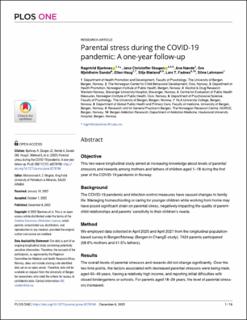| dc.contributor.author | Bjørknes, Ragnhild | |
| dc.contributor.author | Skogen, Jens Christoffer | |
| dc.contributor.author | Nærde, Ane | |
| dc.contributor.author | Sandal, Gro Mjeldheim | |
| dc.contributor.author | Haug, Ellen Merethe Melingen | |
| dc.contributor.author | Mæland, Silje | |
| dc.contributor.author | Fadnes, Lars Thore | |
| dc.contributor.author | Lehmann, Stine | |
| dc.date.accessioned | 2022-12-29T11:44:04Z | |
| dc.date.available | 2022-12-29T11:44:04Z | |
| dc.date.created | 2022-12-09T10:02:48Z | |
| dc.date.issued | 2022-12-06 | |
| dc.identifier.issn | 1932-6203 | |
| dc.identifier.uri | https://hdl.handle.net/11250/3039842 | |
| dc.description.abstract | Objective: This two-wave longitudinal study aimed at increasing knowledge about levels of parental stressors and rewards among mothers and fathers of children aged 1–18 during the first year of the COVID-19 pandemic in Norway.
Background: The COVID-19 pandemic and infection-control measures have caused changes to family life. Managing homeschooling or caring for younger children while working from home may have posed significant strain on parental stress, negatively impacting the quality of parent-child relationships and parents’ sensitivity to their children’s needs.
Method: We employed data collected in April 2020 and April 2021 from the longitudinal population-based survey in Bergen/Norway (Bergen in ChangE-study). 7424 parents participated (58.6% mothers and 41.5% fathers).
Results: The overall levels of parental stressors and rewards did not change significantly. Over the two time points, the factors associated with decreased parental stressors were being male, aged 40–49 years, having a relatively high income, and reporting initial difficulties with closed kindergartens or schools. For parents aged 18–29 years, the level of parental stressors increased.
Conclusion: The study suggests that the overall levels of parental stress remained unchanged during the first year of the pandemic. Even so, the study also uncovered that younger parents represented a vulnerable subgroup. | en_US |
| dc.language.iso | eng | en_US |
| dc.publisher | PLoS | en_US |
| dc.rights | Navngivelse 4.0 Internasjonal | * |
| dc.rights.uri | http://creativecommons.org/licenses/by/4.0/deed.no | * |
| dc.title | Parental stress during the COVID-19 pandemic: A one-year follow-up | en_US |
| dc.type | Journal article | en_US |
| dc.type | Peer reviewed | en_US |
| dc.description.version | publishedVersion | en_US |
| dc.rights.holder | Copyright 2022 the authors | en_US |
| dc.source.articlenumber | e0276190 | en_US |
| cristin.ispublished | true | |
| cristin.fulltext | original | |
| cristin.qualitycode | 1 | |
| dc.identifier.doi | 10.1371/journal.pone.0276190 | |
| dc.identifier.cristin | 2091037 | |
| dc.source.journal | PLOS ONE | en_US |
| dc.identifier.citation | PLOS ONE. 2022, 17 (12), e0276190. | en_US |
| dc.source.volume | 17 | en_US |
| dc.source.issue | 12 | en_US |

